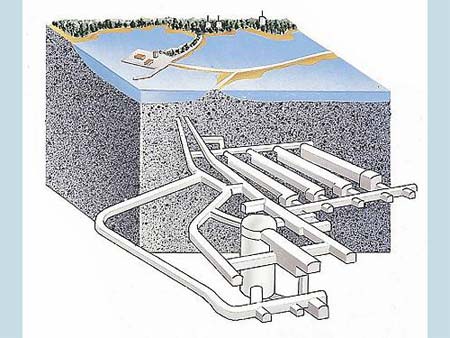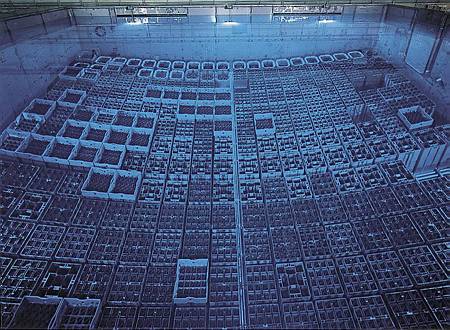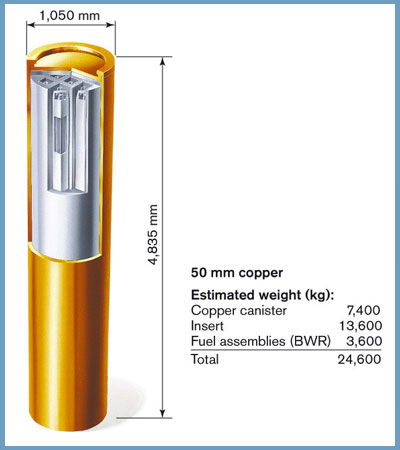Sweden and Finland – Exemplary waste management

Waste silo at SFR
The SFR repository at the Forsmark power plant is designed for permanent disposal of low- and intermediate-level short-lived waste in vaults excavated from a granite formation, approximately 50 m underground.
© SKB

Diagram of SFR
Low and intermediate-level short-lived waste from power plants, hospitals, industrial users and research facilities is sent to SFR, a final disposal facility designed for such waste. SFR was built between 1982 and 1988, at a depth of 50 to 100 m in a rocky substructure under the Baltic sea floor, 1 km off the coast from the Forsmark power plant. Waste is deposited in cavities excavated into the rock, in configurations that vary according to the type of waste. This repository has now been operating for more than 20 years.
© SKB/ Jan M Rojmar
Sweden probably features among the European leaders in terms of radioactive waste management. In addition, there is a general consensus admired and envied by other nations.
Nuclear power accounts for half of the electricity produced in Sweden, with hydroelectric power making up the rest. Per-capita electricity consumption is 40% higher than in France. Paradoxically, therefore, Sweden is dependent on nuclear power and set to remain so for many years, despite being the first country to declare (in 1980) its desire to abandon this form of energy. This goal is rarely mentioned these days.
As the Swedish fleet consists of only 12 reactors, reprocessing irradiated fuel was not considered to be worthwhile. Under the applicable law, power plant owners are responsible for handling and safe disposal of their radioactive waste. In 1972, the four companies that own nuclear power plants joined forces to create a joint organisation named SKB.
SKB developed a comprehensive system to manage all radioactive waste. The organisation’s main tasks relate to the identification, preparation, construction and operation of the necessary facilities enabling safe handling and disposal of irradiated fuel and all radioactive waste. A fund dedicated specifically to the radioactive waste management programme has been in place for the past 20 years, ensuring that the necessary financial resources are available.
The main two installations are the SFR repository for low-level radioactive waste and the CLAB spent fuel interim storage centre. SFR and CLAB are both near-surface underground facilities excavated in granite. They are both located near power plants, in Forsmark and Oskarshamn, respectively, and both have been operating for 20 years with no accidents.

Large interim storage pools at CLAB
SKB also manages the CLAB near-surface interim storage centre, built to hold spent fuel from Swedish reactors in underground pools. CLAB is a centralised pool-based interim storage facility, located at the Oskarshamn nuclear site. It has been operating since 1985 and its capacity has been upgraded to 8,000 tonnes of stored fuel.
© SKB
As a result, they enjoy local popular support: in 1982, SKB was perceived as an intruder that would disrupt the lives of peaceful communities; by 2005, the two communities of Forsmark and Oskarshamn were competing to host a repository. Forsmark was ultimately chosen as the site of a future repository. Construction is scheduled to begin by 2020, enabling the facility to begin operating around 2025. This consensus is worlds apart from the protests that, in France for example, prevented the relevant studies relating to a granite site in the Limousin region. This mentality is nothing new: Julius Caesar is said to have described the ancient Gauls as quarrelsome and belligerent…
Sweden, which has already reached the stage of public acceptance of a repository is now in the process of selecting a site. An underground laboratory near Oskarshamn has been conducting related research since 1995. The Aspö underground laboratory, built 460 m below the surface, is conducting research into final disposal in granite rock as well as the behaviour of granite rock with respect to radioelements. The laboratory is also developing appropriate handling equipment. The facility is toured by tens of thousands of visitors each year.

Sweden: Copper disposal packages
Sweden, which do not reprocess its spent fuel, has developed a disposal process. Carbon steel assembly containers are inserted into over-pack containers with a copper outer shell. The overpacks designed for waste disposal in granite, only suitable geological formation available in Sweden, will be placed in cells to be backfilled with bentonite, a clay that becomes totally impermeable when saturated with water, preventing water that circulates through the granite from reaching the waste packages.
© SKB
Finland has a similar programme to its neighbour, Sweden. Together with Sweden, this small Scandinavian country is among the most advanced in this field. Supported by strong political and economic consensus, the Finnish parliament has adopted the principle of a geological repository. In November 2016, the Safety Authority has authorized the construction of such a repository for spent nuclear fuels. Excavation work began in December 2016.
Posiva Oy is the company assigned to lead the geological repository project in Onkalo, 300 km northwest of Helsinki. The Onkalo centre would be built in granite rock, at 400 m depth, with a network of galleries bored in the granite in the absence of clay sites in the country. It will store 9,000 tonnes of spent nuclear fuel from the four existing reactors and the future EPR reactors. Like Sweden, Finland will store its spent fuel directly.
The operation of the Onkalo storage center, may start by 2023 and is foreseen to continue for a hundred years. It is located near the Olkiluoto nuclear power plant and its EPR reactor under construction.
Furthermore, low- and intermediate-level waste is disposed of in near-surface underground silos excavated from granite near the country’s power plants.
Source: CIGEOMag, March 2013
Other articles on the subject « Geological disposal »
Waste duration
Nuclear spent fuel and vitrified waste: what legacy? “Much of this nuclear waste will remai[...]
CIGEO project
CIGEO – Overview of a planned repository The efforts made by engineers to ensure that highl[...]
Clay medium
The Callovo-Oxfordian argilite The geological stratum or ‘host rock’ that will[...]
Bure underground laboratory
A research laboratory for a disposal facility site Before high-level radioactive waste is buried [...]
Results on deep clay disposal
What we know about the disposal facility site In its final report in 2006 the French National Ass[...]
High-level waste repositories
Disposal of high-level waste packages The high-level waste packages requiring disposal will proba[...]
ILW-LL waste repositories
Filling an intermediate-level waste disposal cell Intermediate-level (ILW-LL) waste releases litt[...]
Waste disposal USA
Back to the drawing board after Yucca Mountain WIPP, the first deep geological repository to begi[...]
WIPP Project
The world’s first deep geological repository The United States is the first country in the [...]
Other countries
Shared challenges and similar solutions In most countries with nuclear industries, solutions for [...]